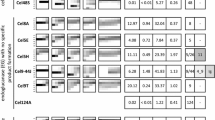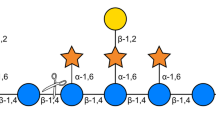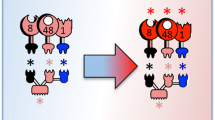Abstract
Cellulosomes are efficient cellulose-degradation systems produced by selected anaerobic bacteria. This multi-enzyme complex is assembled from a group of cellulases attached to a protein scaffold termed scaffoldin, mediated by a high-affinity protein–protein interaction between the enzyme-borne dockerin module and the cohesin module of the scaffoldin. The enzymatic complex is attached as a whole to the cellulosic substrate via a cellulose-binding module (CBM) on the scaffoldin subunit. In previous works, we have employed a synthetic biology approach to convert several of the free cellulases of the aerobic bacterium, Thermobifida fusca, into the cellulosomal mode by replacing each of the enzymes’ CBM with a dockerin. Here we show that although family six enzymes are not a part of any known cellulosomal system, the two family six enzymes of the T. fusca system (endoglucanase Cel6A and exoglucanase Cel6B) can be converted to work as cellulosomal enzymes. Indeed, the chimaeric dockerin-containing family six endoglucanase worked well as a cellulosomal enzyme, and proved to be more efficient than the parent enzyme when present in designer cellulosomes. In stark contrast, the chimaeric family six exoglucanase was markedly less efficient than the wild-type enzyme when mixed with other T. fusca cellulases, thus indicating its incompatibility with the cellulosomal mode of action.




Similar content being viewed by others
References
Barak Y, Handelsman T, Nakar D, Mechaly A, Lamed R, Shoham Y, Bayer EA (2005) Matching fusion-protein systems for affinity analysis of two interacting families of proteins: the cohesin–dockerin interaction. J Mol Recogit 18:491–501
Bayer EA, Morag E, Lamed R (1994) The cellulosome—a treasure-trove for biotechnology. Trends Biotechnol 12:378–386
Bayer EA, Belaich J-P, Shoham Y, Lamed R (2004) The cellulosomes: multi-enzyme machines for degradation of plant cell wall polysaccharides. Annu Rev Microbiol 58:521–554
Bayer EA, Lamed R, Himmel ME (2007) The potential of cellulases and cellulosomes for cellulosic waste management. Curr Opin Biotechnol 18:237–245
Bayer EA, Henrissat B, Lamed R (2008a) The cellulosome: a natural bacterial strategy to combat biomass recalcitrance. In: Himmel ME (ed) Biomass recalcitrance. Blackwell, London, pp 407–426
Bayer EA, Shoham Y, Lamed R (2008b) Cellulosome-enhanced conversion of biomass: on the road to bioethanol. In: Wall J, Harwood C, Demain AL (eds) Bioengergy. ASM Press, Washington, DC, pp 75–96
Berdichevsky Y, Lamed R, Frenkel D, Gophna U, Bayer EA, Yaron S, Shoham Y, Benhar I (1999) Matrix-assisted refolding of single-chain Fv-cellulose binding domain fusion proteins. Protein Expr Purif 17:249–259
Caspi J, Irwin D, Lamed R, Shoham Y, Fierobe H-P, Wilson DB, Bayer EA (2006) Thermobifida fusca family-6 cellulases as potential designer cellulosome components. Biocat Biotransform 24:3–12
Caspi J, Irwin D, Lamed R, Fierobe H-P, Wilson DB, Bayer EA (2008) Conversion of noncellulosomal Thermobifida fusca free exoglucanases into cellulosomal components: comparative impact on cellulose-degrading activity. J Biotechnol 135:351–357
Caspi J, Barak Y, Haimovitz R, Irwin D, Lamed R, Wilson DB, Bayer EA (2009) Conversion of a Thermobifida fusca endoglucanase into the cellulosomal mode: effect of linker length and dockerin position. Appl Environ Microbiol 75:7335–7342
Demain AL, Newcomb M, Wu JH (2005) Cellulase, clostridia, and ethanol. Microbiol Mol Biol Rev 69:124–154
Ding S-Y, Bayer EA, Steiner D, Shoham Y, Lamed R (2000) A scaffoldin of the Bacteroides cellulosolvens cellulosome that contains 11 type II cohesins. J Bacteriol 182:4915–4925
Doi RH, Kosugi A (2004) Cellulosomes: plant-cell-wall-degrading enzyme complexes. Nat Rev Microbiol 2:541–551
Dror TW, Morag E, Rolider A, Bayer EA, Lamed R, Shoham Y (2003a) Regulation of the cellulosomal celS (cel48A) gene of Clostridium thermocellum is growth-rate dependent. J Bacteriol 185:3042–3048
Dror TW, Rolider A, Bayer EA, Lamed R, Shoham Y (2003b) Regulation of expression of scaffoldin-related genes in Clostridium thermocellum. J Bacteriol 185:5109–5116
Dror TW, Rolider A, Bayer EA, Lamed R, Shoham Y (2005) Regulation of major cellulosomal endoglucanases of Clostridium thermocellum differs from that of a prominent cellulosomal xylanase. J Bacteriol 187:2261–2266
Fierobe H-P, Mechaly A, Tardif C, Belaich A, Lamed R, Shoham Y, Belaich J-P, Bayer EA (2001) Design and production of active cellulosome chimeras: selective incorporation of dockerin-containing enzymes into defined functional complexes. J Biol Chem 276:21257–21261
Fierobe H-P, Bayer EA, Tardif C, Czjzek M, Mechaly A, Belaich A, Lamed R, Shoham Y, Belaich J-P (2002) Degradation of cellulose substrates by cellulosome chimeras: substrate targeting versus proximity of enzyme components. J Biol Chem 277:49621–49630
Fierobe H-P, Mingardon F, Mechaly A, Belaich A, Rincon MT, Lamed R, Tardif C, Belaich J-P, Bayer EA (2005) Action of designer cellulosomes on homogeneous versus complex substrates: controlled incorporation of three distinct enzymes into a defined tri-functional scaffoldin. J Biol Chem 280:16325–16334
Ghangas GS, Wilson DB (1988) Cloning of the Thermomonospora fusca endoglucanase E2 gene in Streptomyces lividans: affinity purification and functional domains of the cloned gene product. Appl Environ Microbiol 54:2521–2526
Haimovitz R, Barak Y, Morag E, Voronov-Goldman M, Lamed R, Bayer EA (2008) Cohesin-dockerin microarray: diverse specificities between two complementary families of interacting protein modules. Proteomics 8:968–979
Irwin DC, Zhang S, Wilson DB (2000) Cloning, expression and characterization of a family 48 exocellulase, Cel48A, from Thermobifida fusca. Eur J Biochem 267:4988–4997
Jindou S, Kajino T, Inagaki M, Karita S, Beguin P, Kimura T, Sakka K, Ohmiya K (2004) Interaction between a type-II dockerin domain and a type-II cohesin domain from Clostridium thermocellum cellulosome. Biosci Biotechnol Biochem 68:924–926
Mechaly A, Yaron S, Lamed R, Fierobe H-P, Belaich A, Belaich J-P, Shoham Y, Bayer EA (2000) Cohesin-dockerin recognition in cellulosome assembly: experiment versus hypothesis. Proteins 39:170–177
Mechaly A, Fierobe H-P, Belaich A, Belaich J-P, Lamed R, Shoham Y, Bayer EA (2001) Cohesin-dockerin interaction in cellulosome assembly: a single hydroxyl group of a dockerin domain distinguishes between non-recognition and high-affinity recognition. J Biol Chem 276:9883–9888 Erratum 19678
Mingardon F, Chanal A, López-Contreras AM, Dray C, Bayer EA, Fierobe H-P (2007a) Incorporation of fungal cellulases in bacterial minicellulosomes yields viable, synergistically acting cellulolytic complexes. Appl Environ Microbiol 73:3822–3832
Mingardon F, Chanal A, Tardif C, Bayer EA, Fierobe H-P (2007b) Exploration of new geometries in cellulosome-like chimeras. Appl Environ Microbiol 73:7138–7149
Morag E, Lapidot A, Govorko D, Lamed R, Wilchek M, Bayer EA, Shoham Y (1995) Expression, purification and characterization of the cellulose-binding domain of the scaffoldin subunit from the cellulosome of Clostridium thermocellum. Appl Environ Microbiol 61:1980–1986
Newcomb M, Chen CY, Wu JH (2007) Induction of the celC operon of Clostridium thermocellum by laminaribiose. Proc Natl Acad Sci USA 104:3747–3752
Pagès S, Belaich A, Belaich J-P, Morag E, Lamed R, Shoham Y, Bayer EA (1997) Species-specificity of the cohesin-dockerin interaction between Clostridium thermocellum and Clostridium cellulolyticum: prediction of specificity determinants of the dockerin domain. Proteins 29:517–527
Teeri TT (1997) Crystalline cellulose degradation: new insight into the function of cellobiohydrolases. Trends Biotechnol 15:160–167
Wilson DB (2004) Studies of Thermobifida fusca plant cell wall degrading enzymes. Chem Rec 4:72–82
Wilson DB (2009) Cellulases and biofuels. Curr Opin Biotechnol 20:295–299
Yaron S, Morag E, Bayer EA, Lamed R, Shoham Y (1995) Expression, purification and subunit-binding properties of cohesins 2 and 3 of the Clostridium thermocellum cellulosome. FEBS Lett 360:121–124
Zhang S, Lao G, Wilson DB (1995) Characterization of a Thermomonospora fusca exocellulase. Biochemistry 34:3386–3395
Acknowledgments
The authors are grateful for the expert assistance of Sarah Ouanounou Moraïs throughout the stages of preparation of this manuscript. This research was supported by the Brazilian friends of the Weizmann institute of science Alternative Energy Research Initiative (research grants from Mr. Charles Rothschild, Mr. Mario Fleck, and Roberto, and Renata Ruhman), and by grants from the United States-Israel Binational Science Foundation (BSF), Jerusalem, Israel and by the Israel Science Foundation (Grant nos 966/09 and 159/07). E.A.B. holds The Maynard I. and Elaine Wishner Chair of Bio-organic Chemistry.
Author information
Authors and Affiliations
Corresponding author
Rights and permissions
About this article
Cite this article
Caspi, J., Barak, Y., Haimovitz, R. et al. Thermobifida fusca exoglucanase Cel6B is incompatible with the cellulosomal mode in contrast to endoglucanase Cel6A. Syst Synth Biol 4, 193–201 (2010). https://doi.org/10.1007/s11693-010-9056-1
Received:
Revised:
Accepted:
Published:
Issue Date:
DOI: https://doi.org/10.1007/s11693-010-9056-1




